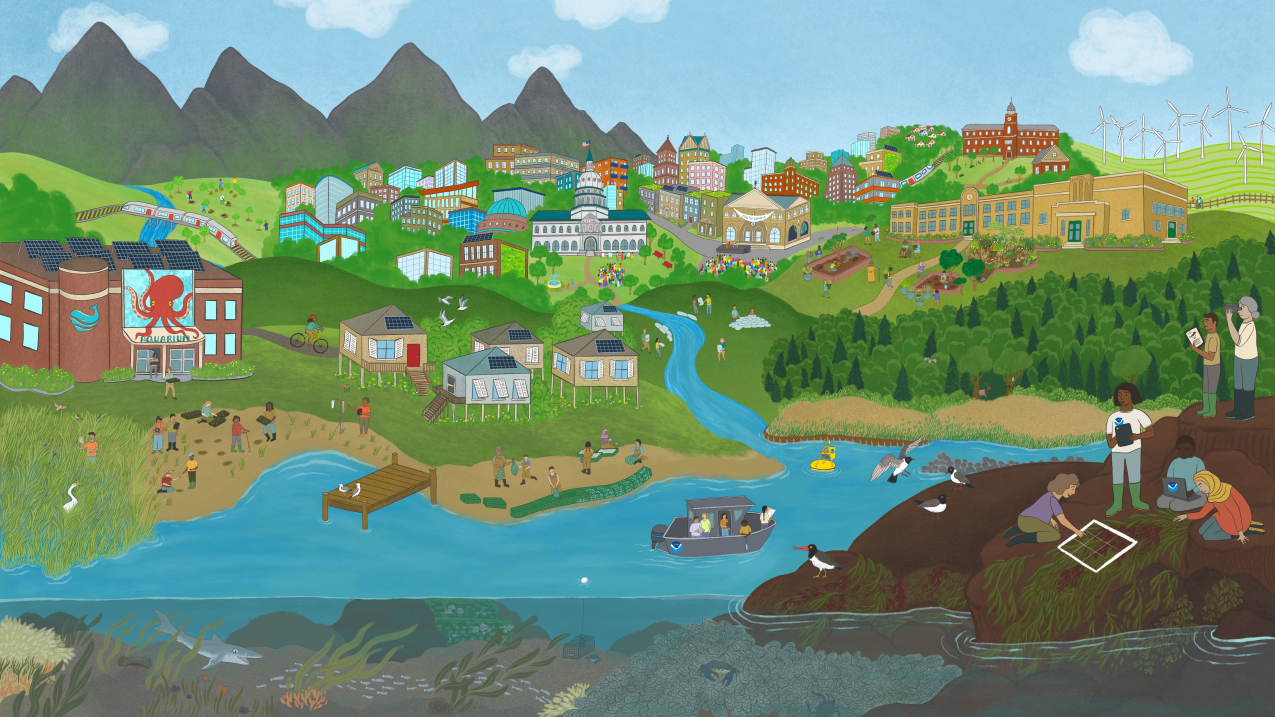
Illustration of the NOAA ELP Vision of A Resilient Community depicting a city along a coast and river with the following depicted: trees being planted as urban heat island abatement; an aquarium with people restoring a nearby coastal wetland to mitigate flooding; sustainable design with green infrastructure; a healthy community with people biking and exercising outside; a city hall with youth and adults presenting their ideas to officials; a shoreline that is protected with restored oyster reefs; students on a boat mapping coastal resilience assets; community members engaging in citizen science; a house adapted to severe storms, flooding, and rising sea levels; people preparing their community for a flood; K-12 schools where teachers and students are creating a rain garden; a university where researchers study resilience solutions; and a science center where youth have convened a climate summit. The NOAA logo is in the top right corner of the illustration. (Image credit: NOAA Office of Education & Jessica B. Bartram, licensed under CC BY-NC-SA 4.0)
NOAA's Community Resilience Education Theory of Change
What is a theory of change & who should use ours?
What's our vision of a resilient community?
Navigate the pathway to change
Explore the causal pathways
Access the report and related resources
NOAA’s Environmental Literacy Program (ELP) supports projects that both inspire and educate people to use Earth system science to increase ecosystem stewardship and resilience to extreme weather, climate change, and other environmental hazards. We’ve developed a theory of change for how and why our grants program’s K-12 formal and informal education projects are critical to building community resilience.
A theory of change is broad in scope and begins with a problem statement and ends with a goal. In between, causal pathways systematically lay out the steps or outcomes that must be met in order to achieve the end goal.
Our theory of change is a living document that will be updated regularly to reflect progress made by ELP, as well as other contributions to the field of community resilience education.
Why did we develop this theory of change?
We’ve developed a community resilience education theory of change to communicate the philosophy guiding our grants program. It provides a new way for us to demonstrate the value of K-12 formal and informal education in local, state, and national efforts to build community resilience to extreme weather, climate change, and other environmental hazards. It also demonstrates the ways in which ELP fills a gap in resilience-building approaches more commonly underway. NOAA’s other resilience efforts focus on creating and promoting the use of science-based information in a work-related context. While building this capacity for workplace use of science-based information is essential, so is equipping people with the environmental literacy necessary to make informed resilience decisions in their everyday lives. When community members become engaged in resilience issues and make informed decisions, they reinforce the efforts of resilience practitioners and local or state officials. In addition to explaining why this is important, our theory of change also outlines how this occurs. Finally, we will use the theory of change to aggregate effective approaches and outcomes identified by our grantees in the future.
How did we develop this theory of change?
Our program has been funding community resilience education projects since 2015, and these projects work together with NOAA as a community of practice. Through this collective knowledge we identified successful approaches and outcomes that are contributing to community resilience. The information we’ve gathered from each project were analyzed to provide the basis for the theory of change. We also consulted relevant theories of change from other programs and conducted an extensive review of published literature in related fields.
Who should use this theory of change and how?
This theory of change serves multiple purposes and audiences. Our colleagues at NOAA, other government offices that support resilience efforts, resilience practitioners, and philanthropic organizations with similar interests may use the rationale for how education is a critical component to achieving resilience. Education professionals and environmental non-governmental organizations may also find this applicable as to how their efforts can contribute to community resilience.
Our grantees can use this as a framework for understanding and mapping how their local efforts contribute to a broader, national effort to increase resilience. More specifically, we intend for our grantees, their partners, and ELP applicants to use this resource to inform project-level logic models and related evaluation, ensuring that their project’s activities and outcomes are aligned with the overall ELP outcomes and goals.
Where can you find more information?
The “Report on the NOAA Office of Education Environmental Literacy Program Community Resilience Education Theory of Change” contains the complete theory of change, an overview of the Environmental Literacy Program history and evolution, an in-depth literature review, and an explanation of how to navigate the theory of change. A comprehensive glossary and bibliography are also included. Online readable versions of the reports are available below. Print-friendly versions and section-by-section breakouts of the reports are available on the “Reports and other resources” tab.
Full report (PDF)
Plain-text report (PDF)
Authors: Genie Bey, Carrie McDougall, and Sarah Schoedinger, NOAA Office of Education
Suggested citation: Bey, G., C. McDougall, & S. Schoedinger. 2020. Report on the NOAA Office of Education Environmental Literacy Program Community Resilience Education Theory of Change. National Oceanic and Atmospheric Administration, Washington, DC. doi:10.25923/mh0g-5q69
Do you have feedback for us on the theory of change? Email us at oed.grants@noaa.gov or contact us on Twitter, Facebook, or Instagram.
The ELP theory of change outlines the conceptual framework for the ways in which community resilience education can lead to increased community engagement and civic action, ultimately leading to a healthier, more resilient, and equitable society.
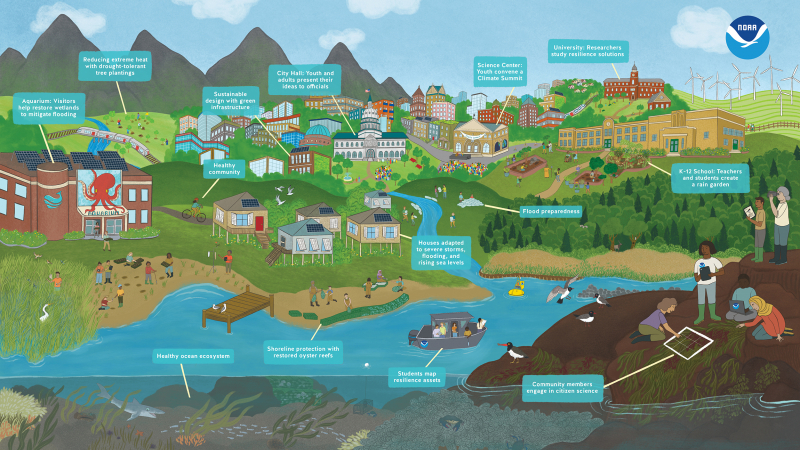
In this illustration of the "ELP Vision of a Resilient Community," the ELP and end goals of the ELP Community Resilience Education Theory of Change are brought to life through a portrayal of the future. The illustration includes all of the major institutional players, such as museums, aquariums, K-12 schools, universities, and other educational and community-based organizations that are involved in community resilience education. It also depicts the key approaches that have been identified as effective. Here, children, youth, and adults are learning together and directly engaged in activities that improve the resilience of their community.
NOAA’s ELP resilience education projects...
-
Build collective environmental literacy;
-
Focus on current and future place-based environmental hazards;
-
Support local and state government resilience efforts through use of resilience plans and creation of new partnerships between education institutions and local or state government offices charged with resilience planning;
-
Incorporate scientific information, including NOAA’s resilience assets;
-
Explore and implement community-scale solutions to improve community resilience;
-
Integrate social, historical, economic, and ecological factors into teaching about the ways human and natural systems interact;
-
Integrate the history, culture, and lived experiences of diverse community members;
-
Promote equitable and inclusive resilience planning that ensures historically marginalized voices are incorporated in the process and contributes to overall community health;
-
Use active learning;
-
Use social learning approaches that cultivate social cohesion;
-
Facilitate opportunities for civic engagement and enable audiences to take action in their communities;
-
Inspire hope and empower agents of change;
-
Build capacity within education systems to address community resilience; and
-
Develop successful community resilience education approaches that contribute to the ELP Community of Practice.
Definition of community resilience education
Educational approaches that develop community-level environmental literacy to understand threats and implement solutions that build resilience to extreme weather, climate change, and other environmental hazards. Environmental literacy here includes the knowledge, skills, and confidence to:
- Reason about the ways that human and natural systems interact globally and locally, including the acknowledgement of disproportionately distributed vulnerabilities;
- Participate in civic processes; and
- Incorporate scientific information, cultural knowledge, and diverse community values when taking action to anticipate, prepare for, respond to, and recover from environmental hazards, including mitigating and adapting to climate change.
The "Pathway to Change" diagram maps the major outcomes identified in the six causal pathways and relates these to the problem statement, interventions, and goals. This depiction can be thought of as the abstract of the entire theory of change.
Theories of change typically include an end goal that is idealistic and far-reaching. The end goal here is large in scope, and it cannot be accomplished by NOAA or ELP alone. Therefore, an intermediate goal that articulates how ELP contributes to the end goal has also been written and is referred to as the ELP goal. Interventions provided by the agency and program show how both are working to address the challenges laid out in the problem statement to achieve the end goal.
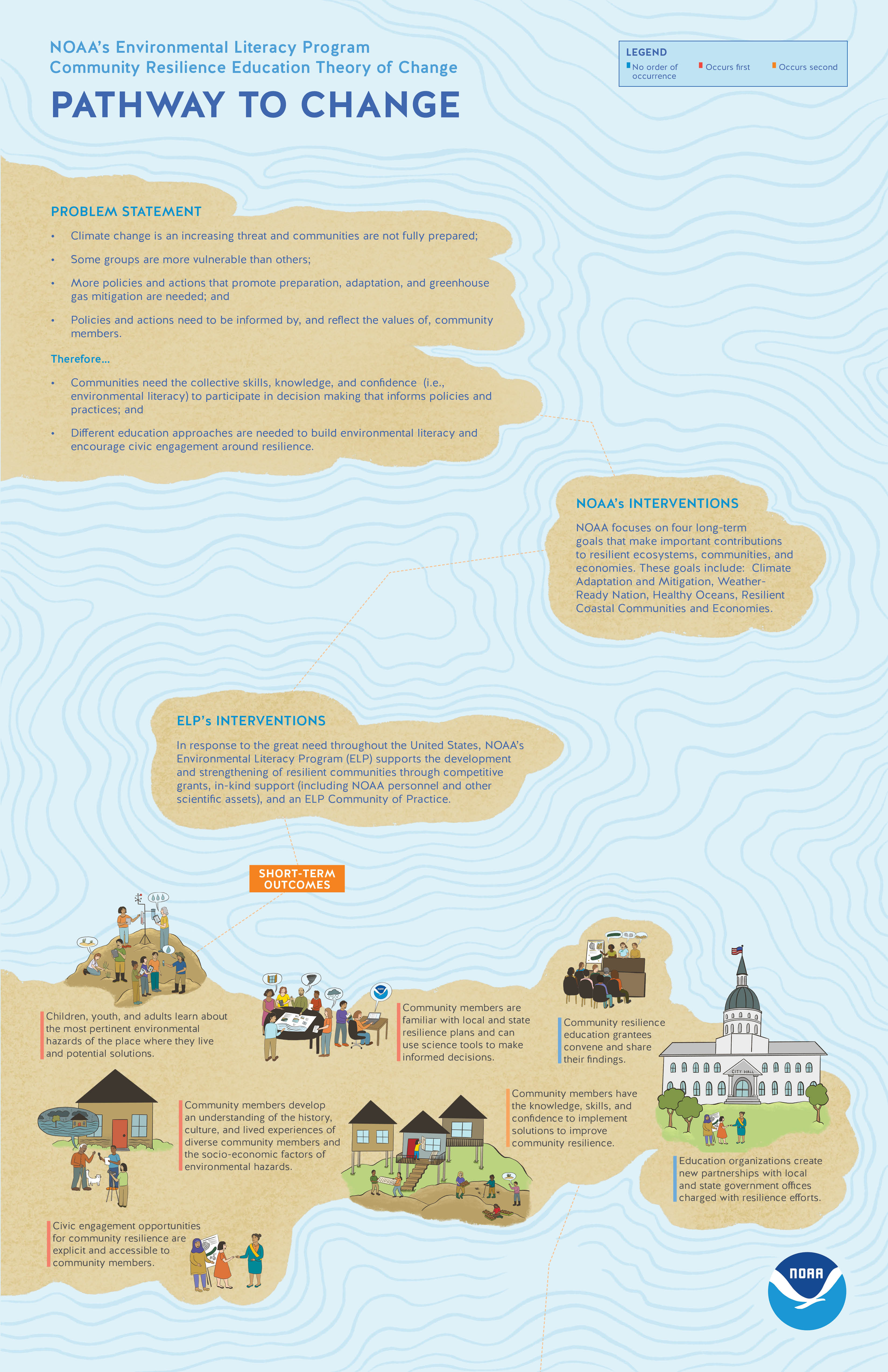

A text-based version of the Pathway to Change is available in the report.
Causal pathways systematically lay out the steps, or short-, mid-, and long-term outcomes that must be met to achieve the end goal. Six causal pathways have been identified based on the approaches and outcomes from community resilience education projects that ELP has funded and assumptions gleaned from our literature review.
These causal pathways are not the only means to achieve community resilience through education, nor are they meant to be prescriptive. Successful projects may achieve outcomes in several different causal pathways and not all projects will achieve all of the long-term outcomes in a pathway. Most of the short- and mid-term outcomes encompassed in these pathways are already occurring in existing projects, whereas the long-term outcomes are aspirational and may occur with more effort (i.e., more than one project) and over a longer time period. Community resilience education projects can be evaluated based on pathway outcomes, although impact evaluation would likely include outcomes specific to project goals and context.
These diagrams illustrate the outcomes we have identified in each causal pathway. In total, more than 100 outcomes were identified across the six causal pathways and the Pathway to Change. Text-based versions of the Pathway to Change and the six causal pathways are included in the appendix of the report.
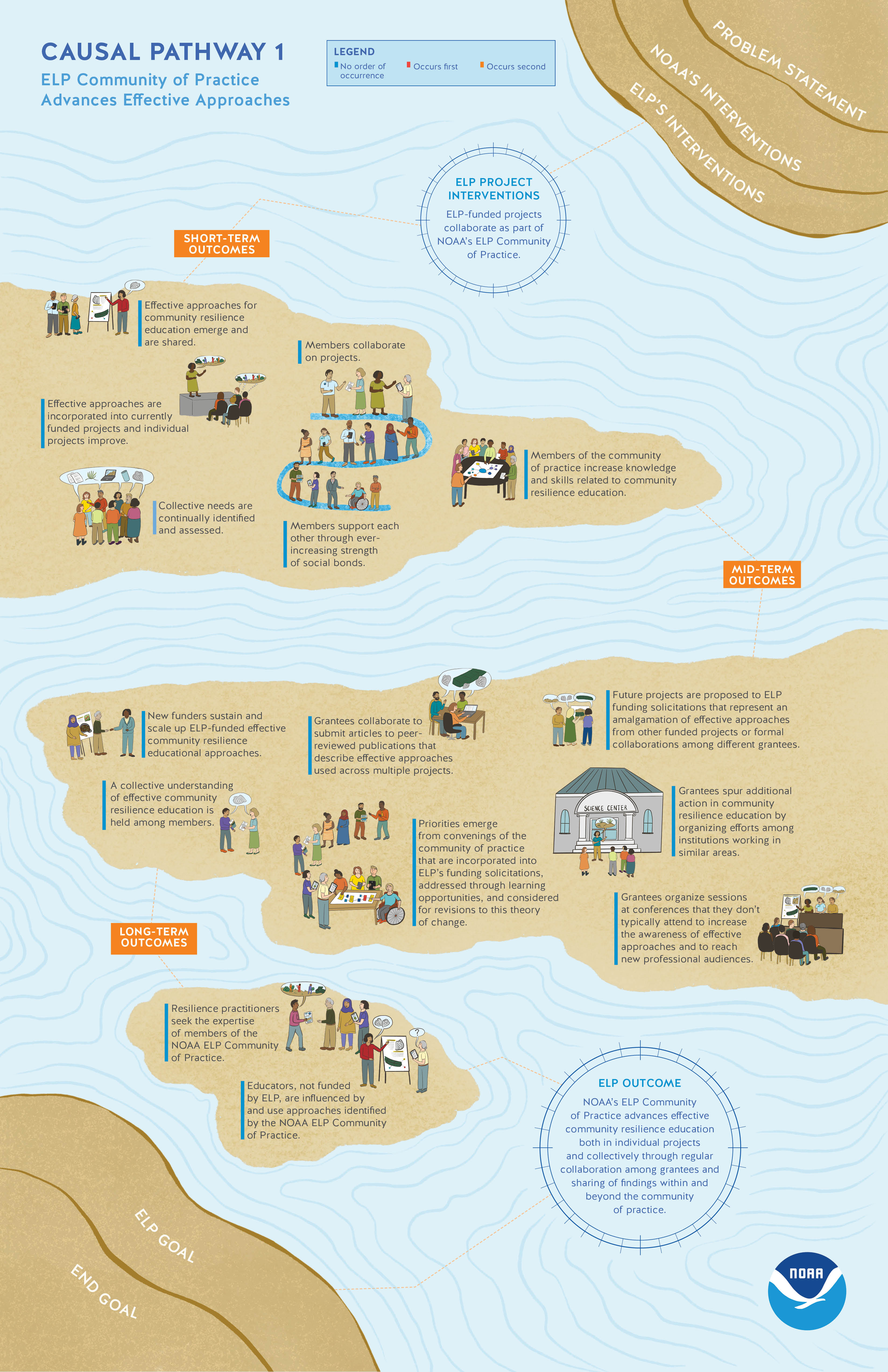
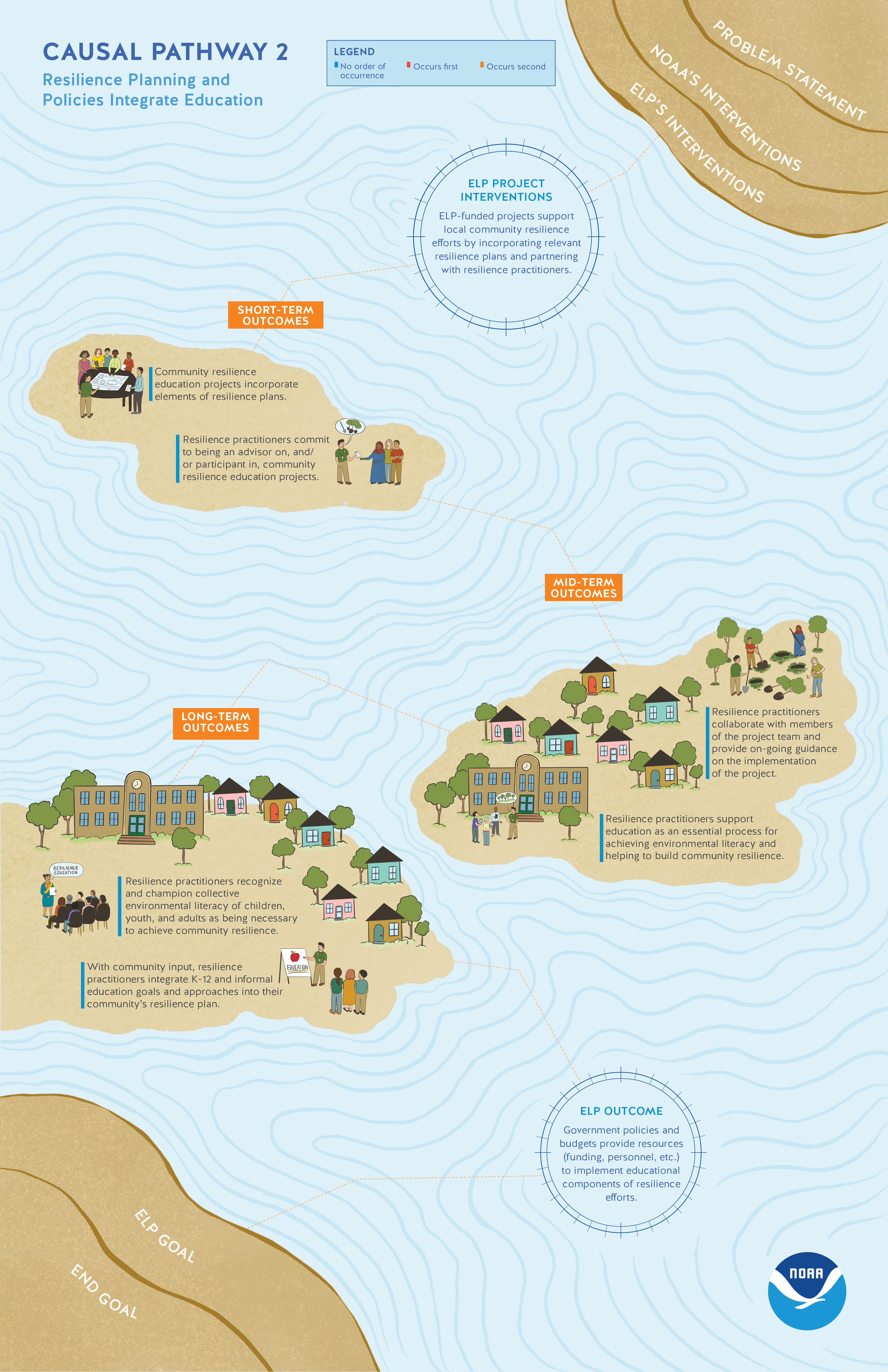
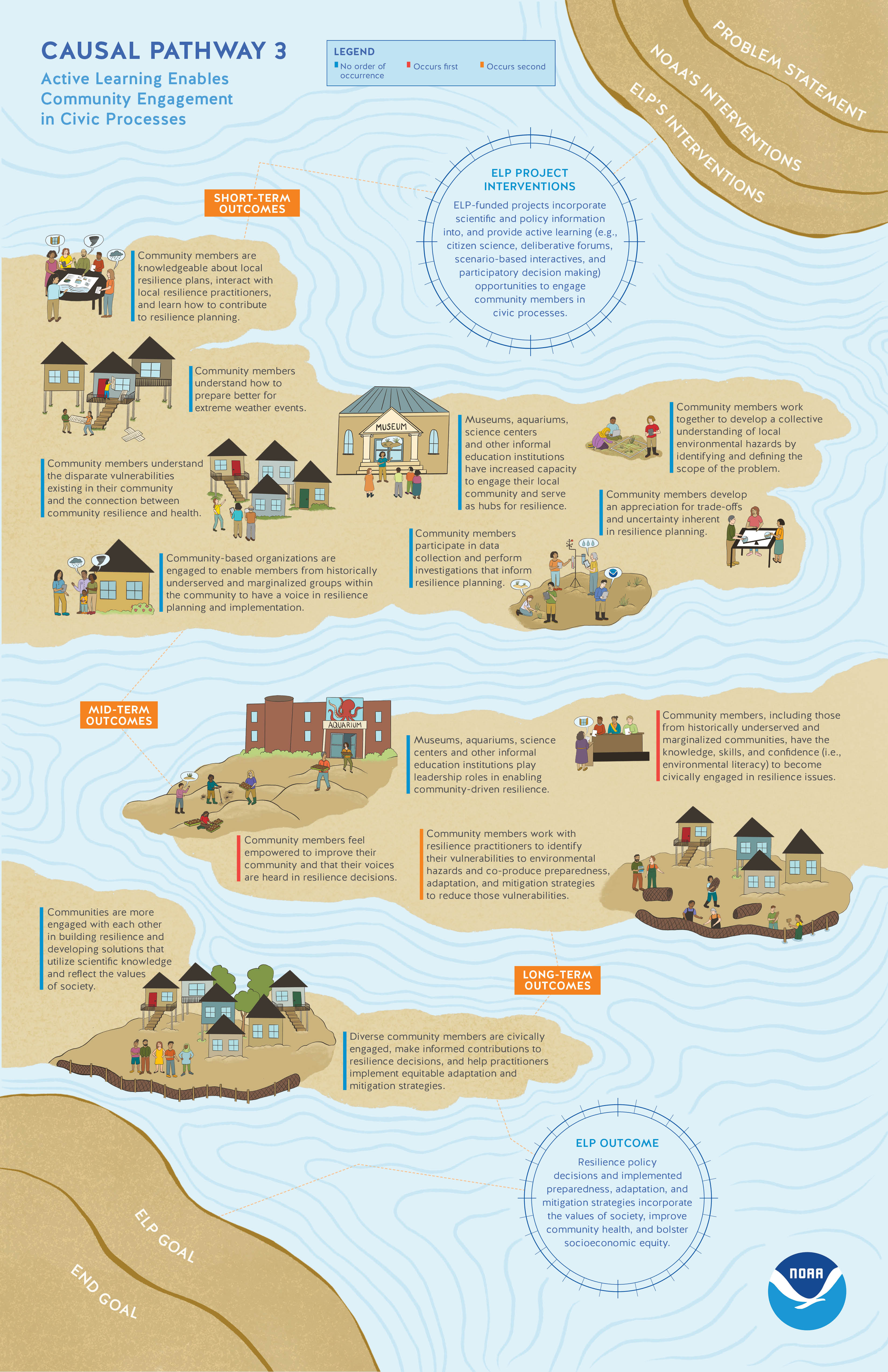
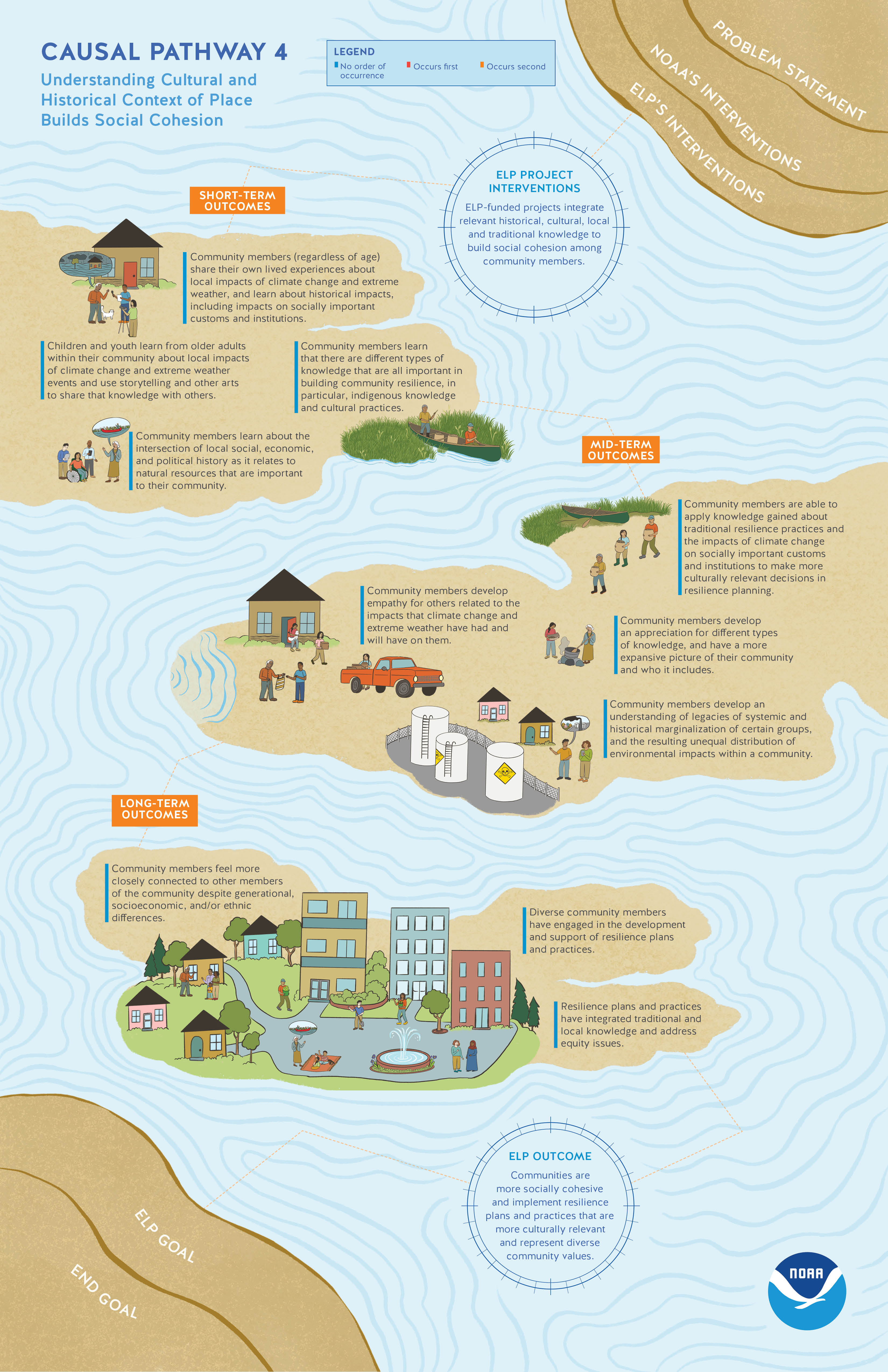
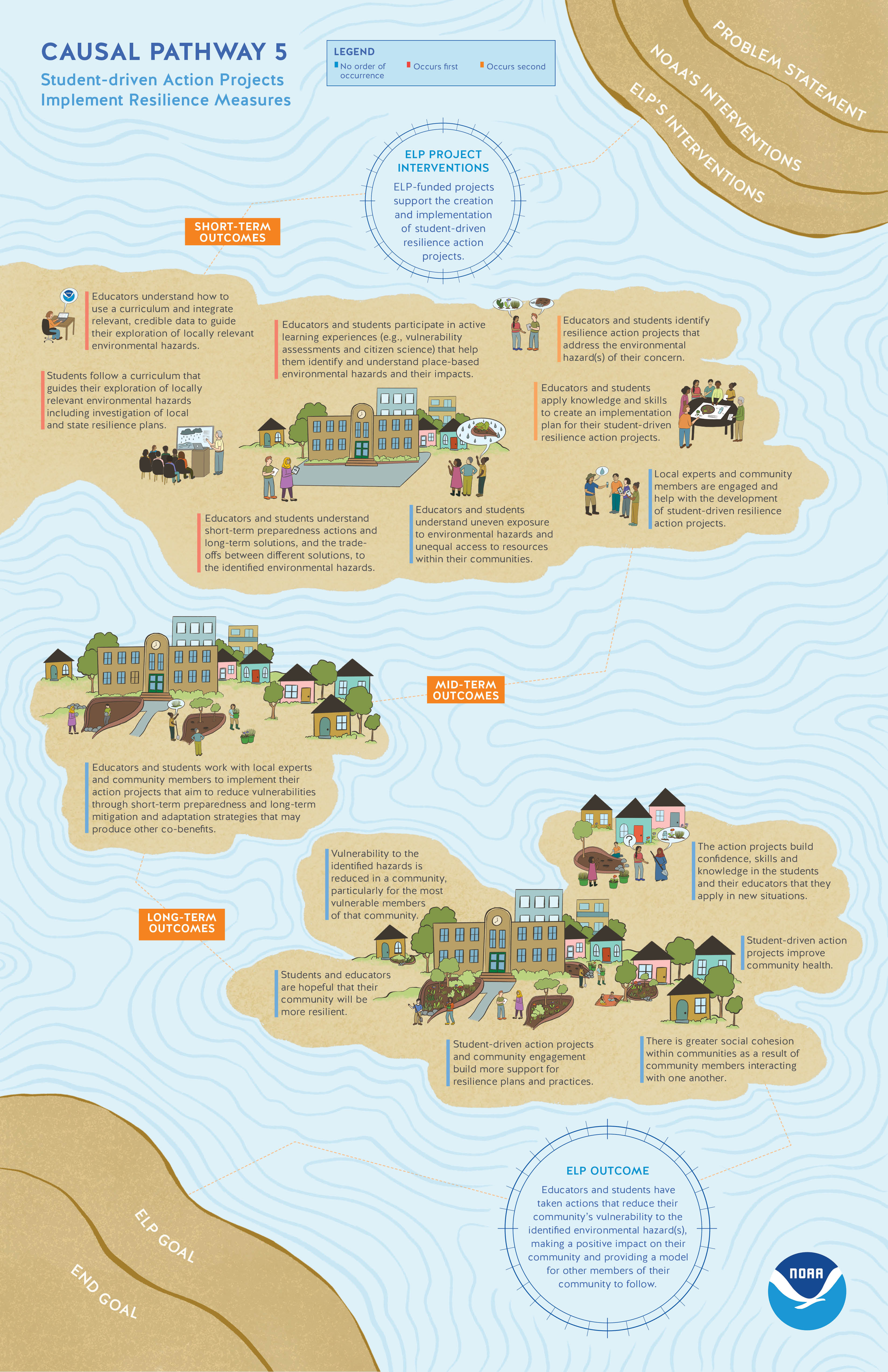
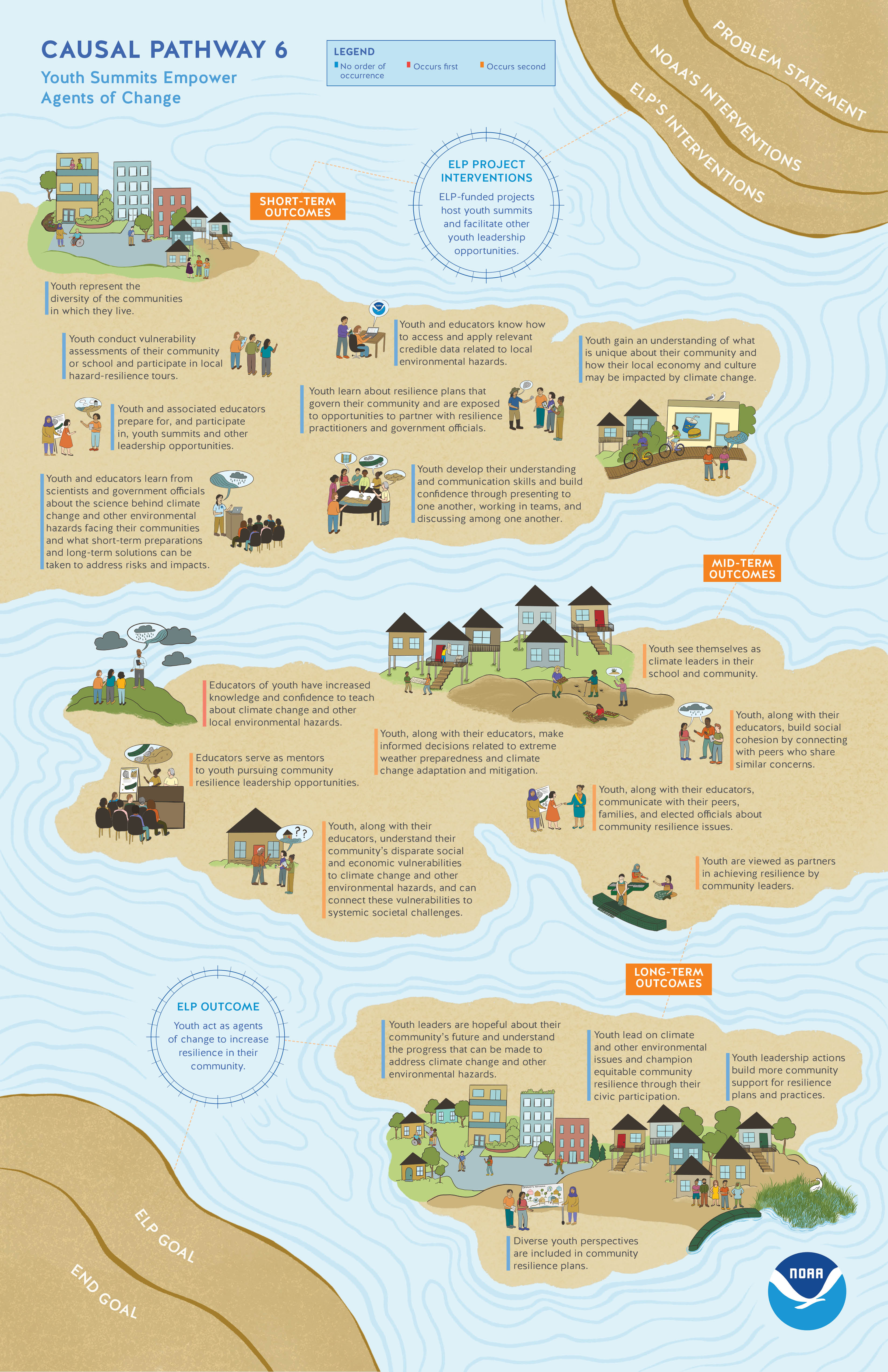
Text-based versions of the causal pathways are available in the report.
The “Report on the NOAA Office of Education Environmental Literacy Program Community Resilience Education Theory of Change” contains the complete theory of change, an overview of the Environmental Literacy Program history and evolution, an in-depth literature review, and an explanation of how to navigate the theory of change. A comprehensive glossary and bibliography are also included. There are several versions of the report available below.

Authors: Genie Bey, Carrie McDougall, and Sarah Schoedinger, NOAA Office of Education
Suggested citation: Bey, G., C. McDougall, & S. Schoedinger. 2020. Report on the NOAA Office of Education Environmental Literacy Program Community Resilience Education Theory of Change. National Oceanic and Atmospheric Administration, Washington, DC. doi:10.25923/mh0g-5q69
© Any version of this publication may be redistributed non-commercially in any media, unchanged and in whole, with credit given to the NOAA Office of Education.
All images credit: NOAA Office of Education & Jessica B. Bartram, licensed under CC BY-NC-SA 4.0 offsite link
Web-optimized files
-
Full report (PDF)
-
Plain-text report (PDF)
-
Report sections (all in PDF):
Printable files
-
Full report (PDF)
-
Executive summary (PDF)
-
Plain-text report (PDF)
Other resources
- Climate Resilience in Your Community Activity Book
- Resilient community coloring page
- An SOS dataset on NOAA's vision of a resilient community, including a paper globe cutout
- Video: The design process of the Theory of Change - a presentation from the virtual American Geophysical Union fall meeting in December 2020, describing how the Theory of Change used illustration and design to evoke visions of a more sustainable future
Do you have feedback for us on the theory of change? Email us at oed.grants@noaa.gov or contact us on Twitter, Facebook, or Instagram.
NOAA’s Environmental Literacy Program (ELP) supports projects that both inspire and educate people to use Earth system science to increase ecosystem stewardship and resilience to extreme weather, climate change, and other environmental hazards. We’ve developed a theory of change for how and why our grants program’s K-12 formal and informal education projects are critical to building community resilience.
A theory of change is broad in scope and begins with a problem statement and ends with a goal. In between, causal pathways systematically lay out the steps or outcomes that must be met in order to achieve the end goal.
Our theory of change is a living document that will be updated regularly to reflect progress made by ELP, as well as other contributions to the field of community resilience education.
Why did we develop this theory of change?
We’ve developed a community resilience education theory of change to communicate the philosophy guiding our grants program. It provides a new way for us to demonstrate the value of K-12 formal and informal education in local, state, and national efforts to build community resilience to extreme weather, climate change, and other environmental hazards. It also demonstrates the ways in which ELP fills a gap in resilience-building approaches more commonly underway. NOAA’s other resilience efforts focus on creating and promoting the use of science-based information in a work-related context. While building this capacity for workplace use of science-based information is essential, so is equipping people with the environmental literacy necessary to make informed resilience decisions in their everyday lives. When community members become engaged in resilience issues and make informed decisions, they reinforce the efforts of resilience practitioners and local or state officials. In addition to explaining why this is important, our theory of change also outlines how this occurs. Finally, we will use the theory of change to aggregate effective approaches and outcomes identified by our grantees in the future.
How did we develop this theory of change?
Our program has been funding community resilience education projects since 2015, and these projects work together with NOAA as a community of practice. Through this collective knowledge we identified successful approaches and outcomes that are contributing to community resilience. The information we’ve gathered from each project were analyzed to provide the basis for the theory of change. We also consulted relevant theories of change from other programs and conducted an extensive review of published literature in related fields.
Who should use this theory of change and how?
This theory of change serves multiple purposes and audiences. Our colleagues at NOAA, other government offices that support resilience efforts, resilience practitioners, and philanthropic organizations with similar interests may use the rationale for how education is a critical component to achieving resilience. Education professionals and environmental non-governmental organizations may also find this applicable as to how their efforts can contribute to community resilience.
Our grantees can use this as a framework for understanding and mapping how their local efforts contribute to a broader, national effort to increase resilience. More specifically, we intend for our grantees, their partners, and ELP applicants to use this resource to inform project-level logic models and related evaluation, ensuring that their project’s activities and outcomes are aligned with the overall ELP outcomes and goals.
Where can you find more information?
The “Report on the NOAA Office of Education Environmental Literacy Program Community Resilience Education Theory of Change” contains the complete theory of change, an overview of the Environmental Literacy Program history and evolution, an in-depth literature review, and an explanation of how to navigate the theory of change. A comprehensive glossary and bibliography are also included. Online readable versions of the reports are available below. Print-friendly versions and section-by-section breakouts of the reports are available on the “Reports and other resources” tab.
Full report (PDF)
Plain-text report (PDF)
Authors: Genie Bey, Carrie McDougall, and Sarah Schoedinger, NOAA Office of Education
Suggested citation: Bey, G., C. McDougall, & S. Schoedinger. 2020. Report on the NOAA Office of Education Environmental Literacy Program Community Resilience Education Theory of Change. National Oceanic and Atmospheric Administration, Washington, DC. doi:10.25923/mh0g-5q69
Do you have feedback for us on the theory of change? Email us at oed.grants@noaa.gov or contact us on Twitter, Facebook, or Instagram.
The ELP theory of change outlines the conceptual framework for the ways in which community resilience education can lead to increased community engagement and civic action, ultimately leading to a healthier, more resilient, and equitable society.

In this illustration of the "ELP Vision of a Resilient Community," the ELP and end goals of the ELP Community Resilience Education Theory of Change are brought to life through a portrayal of the future. The illustration includes all of the major institutional players, such as museums, aquariums, K-12 schools, universities, and other educational and community-based organizations that are involved in community resilience education. It also depicts the key approaches that have been identified as effective. Here, children, youth, and adults are learning together and directly engaged in activities that improve the resilience of their community.
NOAA’s ELP resilience education projects...
-
Build collective environmental literacy;
-
Focus on current and future place-based environmental hazards;
-
Support local and state government resilience efforts through use of resilience plans and creation of new partnerships between education institutions and local or state government offices charged with resilience planning;
-
Incorporate scientific information, including NOAA’s resilience assets;
-
Explore and implement community-scale solutions to improve community resilience;
-
Integrate social, historical, economic, and ecological factors into teaching about the ways human and natural systems interact;
-
Integrate the history, culture, and lived experiences of diverse community members;
-
Promote equitable and inclusive resilience planning that ensures historically marginalized voices are incorporated in the process and contributes to overall community health;
-
Use active learning;
-
Use social learning approaches that cultivate social cohesion;
-
Facilitate opportunities for civic engagement and enable audiences to take action in their communities;
-
Inspire hope and empower agents of change;
-
Build capacity within education systems to address community resilience; and
-
Develop successful community resilience education approaches that contribute to the ELP Community of Practice.
Definition of community resilience education
Educational approaches that develop community-level environmental literacy to understand threats and implement solutions that build resilience to extreme weather, climate change, and other environmental hazards. Environmental literacy here includes the knowledge, skills, and confidence to:
- Reason about the ways that human and natural systems interact globally and locally, including the acknowledgement of disproportionately distributed vulnerabilities;
- Participate in civic processes; and
- Incorporate scientific information, cultural knowledge, and diverse community values when taking action to anticipate, prepare for, respond to, and recover from environmental hazards, including mitigating and adapting to climate change.
The "Pathway to Change" diagram maps the major outcomes identified in the six causal pathways and relates these to the problem statement, interventions, and goals. This depiction can be thought of as the abstract of the entire theory of change.
Theories of change typically include an end goal that is idealistic and far-reaching. The end goal here is large in scope, and it cannot be accomplished by NOAA or ELP alone. Therefore, an intermediate goal that articulates how ELP contributes to the end goal has also been written and is referred to as the ELP goal. Interventions provided by the agency and program show how both are working to address the challenges laid out in the problem statement to achieve the end goal.


A text-based version of the Pathway to Change is available in the report.
Causal pathways systematically lay out the steps, or short-, mid-, and long-term outcomes that must be met to achieve the end goal. Six causal pathways have been identified based on the approaches and outcomes from community resilience education projects that ELP has funded and assumptions gleaned from our literature review.
These causal pathways are not the only means to achieve community resilience through education, nor are they meant to be prescriptive. Successful projects may achieve outcomes in several different causal pathways and not all projects will achieve all of the long-term outcomes in a pathway. Most of the short- and mid-term outcomes encompassed in these pathways are already occurring in existing projects, whereas the long-term outcomes are aspirational and may occur with more effort (i.e., more than one project) and over a longer time period. Community resilience education projects can be evaluated based on pathway outcomes, although impact evaluation would likely include outcomes specific to project goals and context.
These diagrams illustrate the outcomes we have identified in each causal pathway. In total, more than 100 outcomes were identified across the six causal pathways and the Pathway to Change. Text-based versions of the Pathway to Change and the six causal pathways are included in the appendix of the report.






Text-based versions of the causal pathways are available in the report.
The “Report on the NOAA Office of Education Environmental Literacy Program Community Resilience Education Theory of Change” contains the complete theory of change, an overview of the Environmental Literacy Program history and evolution, an in-depth literature review, and an explanation of how to navigate the theory of change. A comprehensive glossary and bibliography are also included. There are several versions of the report available below.

Authors: Genie Bey, Carrie McDougall, and Sarah Schoedinger, NOAA Office of Education
Suggested citation: Bey, G., C. McDougall, & S. Schoedinger. 2020. Report on the NOAA Office of Education Environmental Literacy Program Community Resilience Education Theory of Change. National Oceanic and Atmospheric Administration, Washington, DC. doi:10.25923/mh0g-5q69
© Any version of this publication may be redistributed non-commercially in any media, unchanged and in whole, with credit given to the NOAA Office of Education.
All images credit: NOAA Office of Education & Jessica B. Bartram, licensed under CC BY-NC-SA 4.0 offsite link
Web-optimized files
-
Full report (PDF)
-
Plain-text report (PDF)
-
Report sections (all in PDF):
Printable files
-
Full report (PDF)
-
Executive summary (PDF)
-
Plain-text report (PDF)
Other resources
- Climate Resilience in Your Community Activity Book
- Resilient community coloring page
- An SOS dataset on NOAA's vision of a resilient community, including a paper globe cutout
- Video: The design process of the Theory of Change - a presentation from the virtual American Geophysical Union fall meeting in December 2020, describing how the Theory of Change used illustration and design to evoke visions of a more sustainable future
Do you have feedback for us on the theory of change? Email us at oed.grants@noaa.gov or contact us on Twitter, Facebook, or Instagram.


